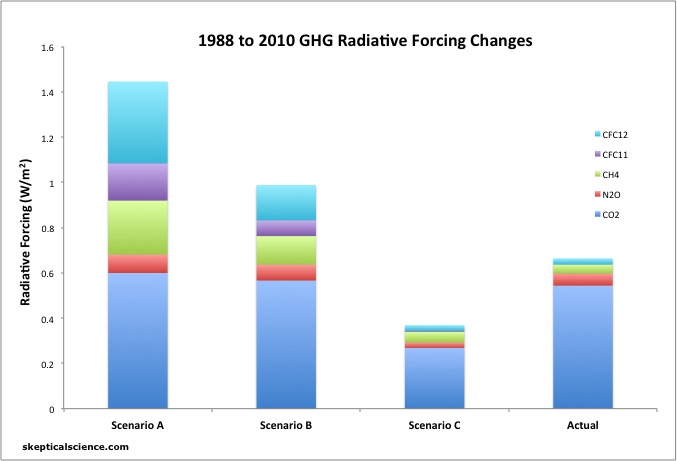
Note: Jan-Erik Solheim has just recently made some very incorrect claims about Hansen 1988, which we will debunk later this week. Consider this post a brief primer.
Earlier this year in a post Patrick Michaels Continues to Distort Hansen 1988, Part 1, we compared Patrick Michaels' claims about Hansen et al. (1988) in his 1998 testimony before US Congress to reality. As Figure 1 shows, we found that Michaels had distorted reality, telling Congress that Hansen's Scenario A was closest to reality, when in fact the actual 1988 to 1998 radiative forcing changes weren't even quite as large as in Scenario C.
Figure 1: Radiative forcing contributions from 1988 to 1998 from CO2 (dark blue), N2O (red), CH4 (green), CFC-11 (purple), and CFC-12 (light blue) in each of the scenarios modeled in Hansen et al. 1988, vs. observations (NOAA).
Michaels had claimed Scenario A was accurate because at one point Hansen described it as "business as usual" (BAU). However, between 1988 and 1998 some major events occurred, such as passage of the Montreal Protocol international agreement to reduce chlorofluorocarbon (CFC) emissions, and the collapse of the Soviet Union. Thus, while it is debatable whether Scenario A truly represents a BAU scenario (we argued that it would be more accurate to describe Scenario B as BAU - see Figure 2 below), we did not follow a BAU path over this timeframe anyway. But more importantly, in terms of the greenhouse gas (GHG) radiative forcing (which is what Hansen's model responded to), Scenario C was the closest to reality as of 1998.
However, this post focused primarily on the radiative forcings as of 1998, and only briefly touched on the up-to-date radiative forcing data (Figure 2).
Figure 2: Radiative forcing changes (1988 to 2010) for the three emissions scenarios in Hansen et al. 1988 (dark blue [A], red [B], and green [C]) vs. Skeie et al. (2011) GHG-only (light blue) and all anthropogenic forcings (purple), and business as usual (BAU) GHG based on a rate of increase consistent with the Skeie et al. estimate for 1978 to 1988 (gray, dashed).
We recently received a request to update Figure 1 to essentially break out the light blue curve in Figure 2 for the various individual GHGs. This update is shown in Figure 3.

Figure 3: Radiative forcing contributions from 1988 to 2010 from CO2 (dark blue), N2O (red), CH4 (green), CFC-11 (purple), and CFC-12 (light blue) in each of the scenarios modeled in Hansen et al. 1988, vs. observations (NOAA).
As Figures 2 and 3 show, the net GHG forcing has fallen smack dab between Scenarios B and C. The CO2 and N2O increases have been closest to Scenario B, whereas the methane and CFC increases have been closest to Scenario C, though even somewhat lower. The Montreal Protocol has been a major success, as the CFC increases over the past 22 years have been almost zero. In fact, the 2010 atmospheric CFC-11 concentration was actually slightly below its 1988 level.
As noted above, this analysis only considers long-lived GHGs. According to Skeie et al. (2011), the radiative forcings associated with ozone (another GHG) and land use change have also increased. The direct aerosol cooling effect also decreased during the 1990s. Therefore, the net 1988-2010 radiative forcing has increased at a rate closest to Scenario B, but approximately 16% lower, as illustrated by the purple curve in Figure 2.
In short, claims that actual emissions have followed a Scenario A path are wrong, and usually based on rhetoric (i.e. 'Hansen said Scenario A was BAU' - Michaels' argument) or an undue focus on CO2 (i.e. 'CO2 emissions have accelerated, as expected in Scenario A - the Solheim argument we will see later this week). In fact, CO2 concentrations and forcings don't start to differ significantly between Scenarios A and B until after 2020. The main difference between the various scenarios, as Illustrated in Figure 3, is in CFCs and methane The real-world emissions of these GHGs have been quite low - even lower than in Scenario C.
Overall in order to evaluate which scenario has been closest to reality, we need to evaluate all radiative forcings. In terms of GHGs only, the result has fallen between Scenarios B and C. In terms of all radiative forcings, the result has fallen closest to and about 16% below Scenario B. Scenario A is the furthest from reality, which is a very fortunate result.
Posted by dana1981 on Sunday, 17 June, 2012
 |
The Skeptical Science website by Skeptical Science is licensed under a Creative Commons Attribution 3.0 Unported License. |